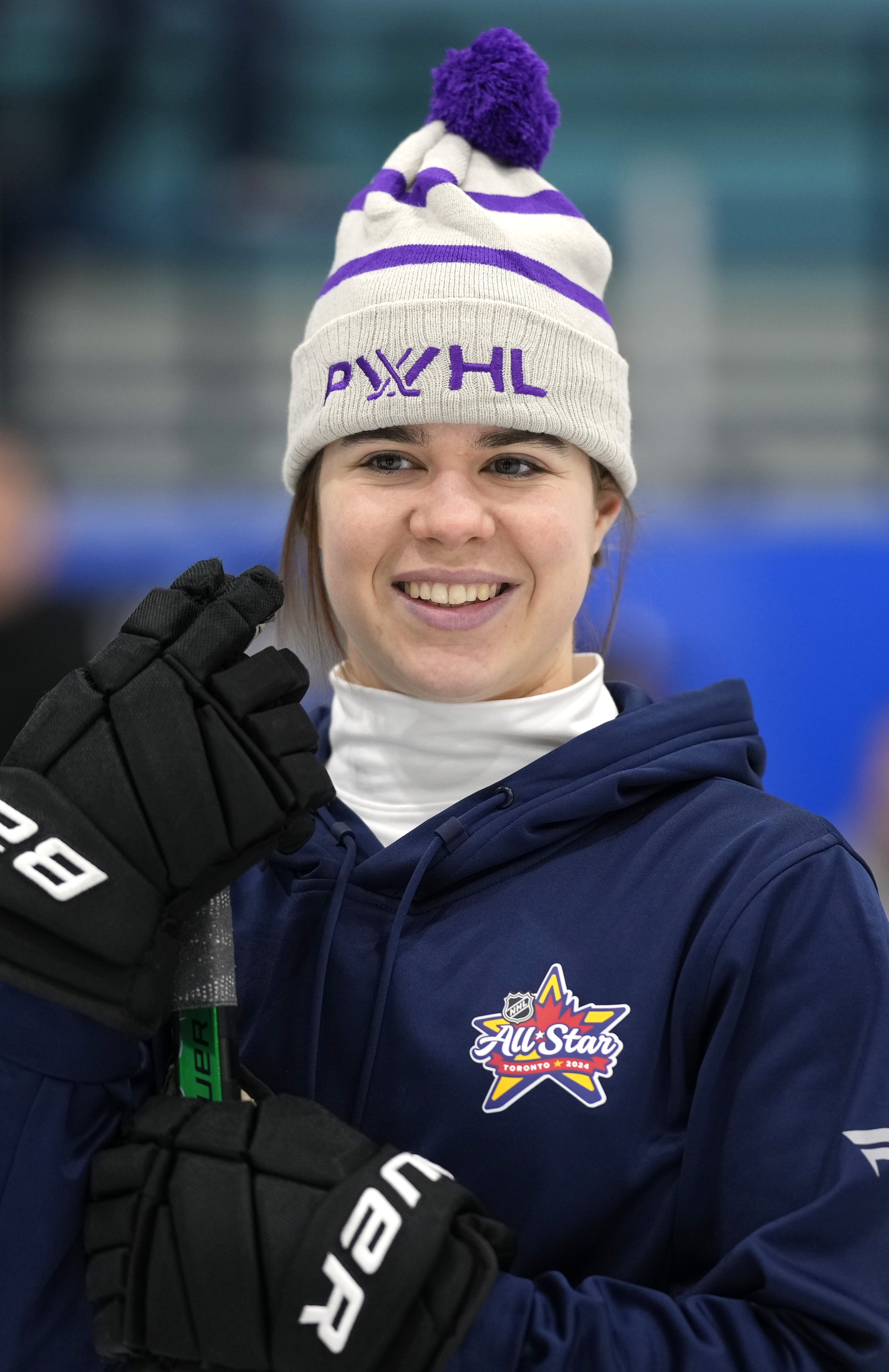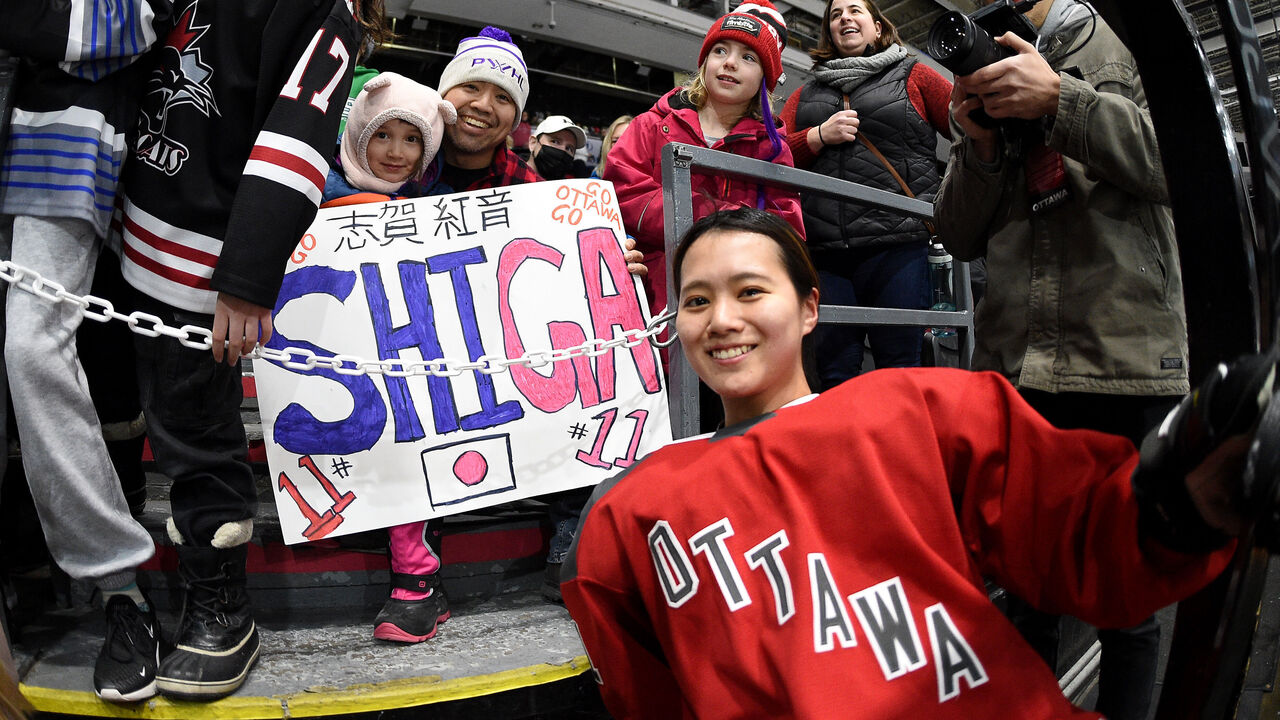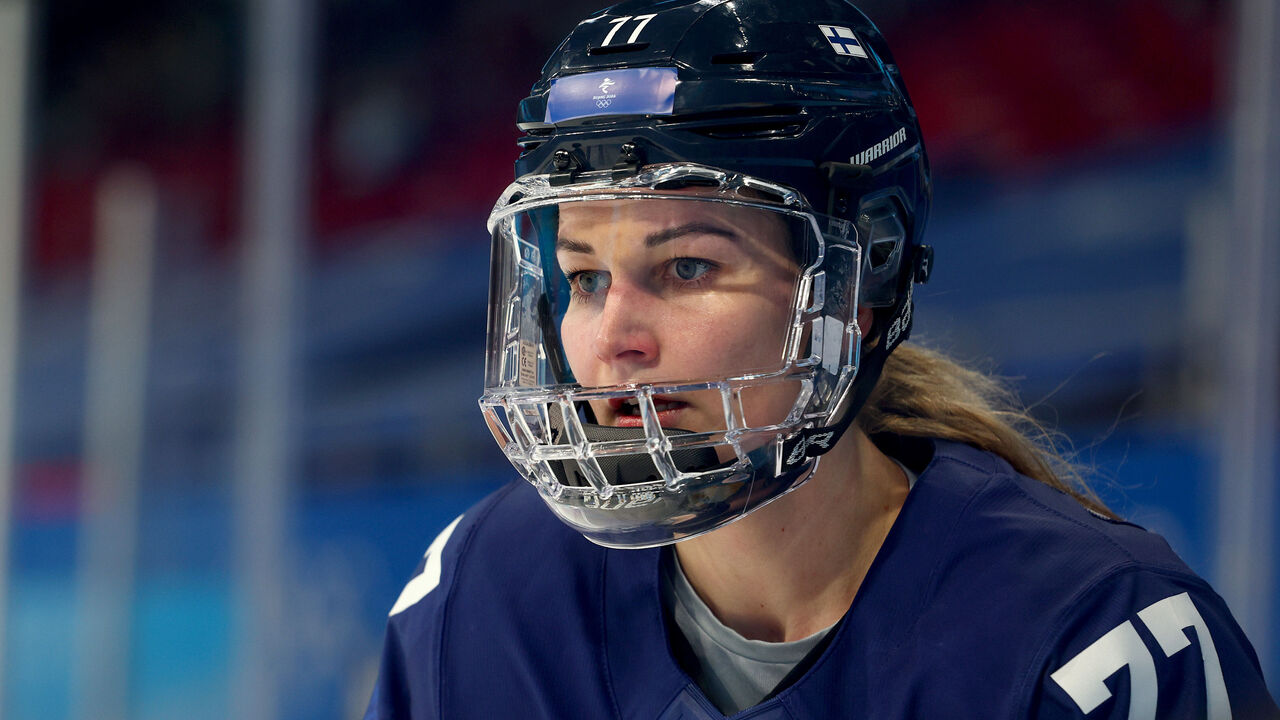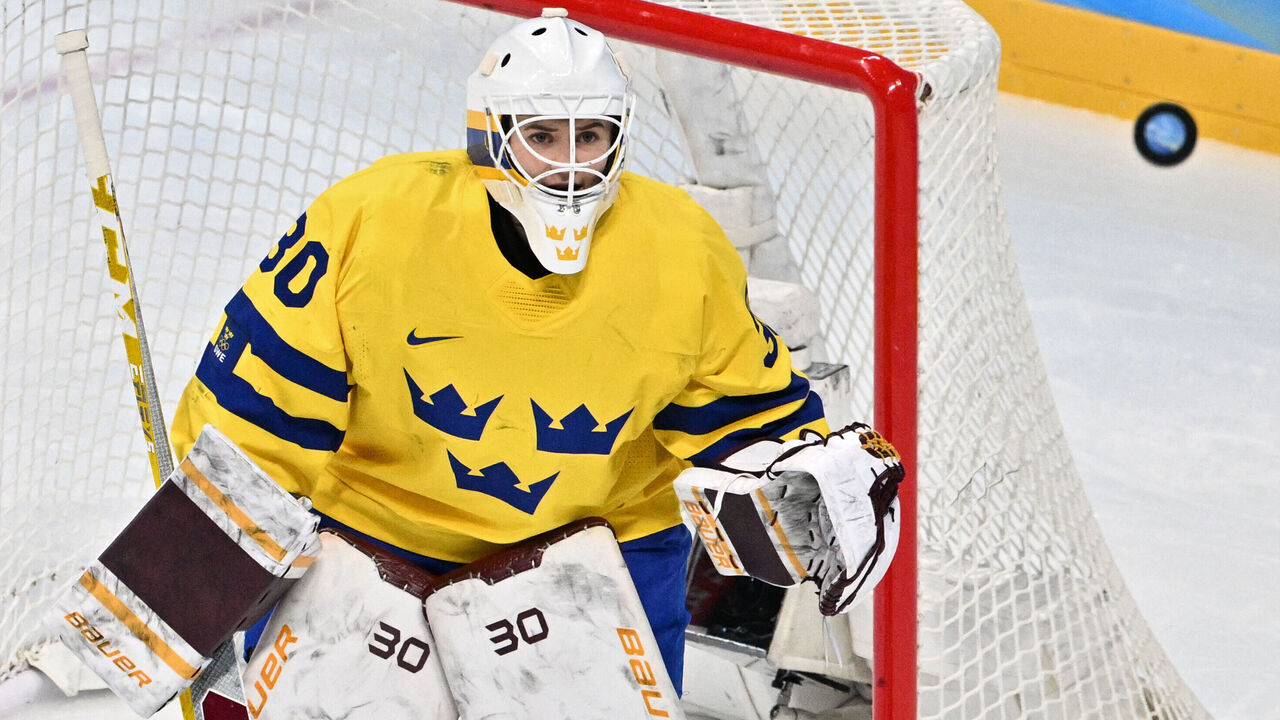How the PWHL's European trailblazers proved they belong
Johanna Fallman scored twice, set up another three goals, and dropped the gloves to police wrongdoing. Years later, she laughed about the bizarre feat.
Fallman's hometown team, powerhouse Lulea, trounced a basement-dwelling Swedish Women's Hockey League opponent in 2019. Time blurred her memory of scoring in the 14-0 win. Fallman, a hard-nosed defender, assumes she got on the board in "some ugly scrum" while crashing the crease on the power play.
Since women's hockey forbids fighting, few players complete Gordie Howe's famous trifecta. Fallman was ejected when she sparked a tussle toward the end of the blowout. Haymakers weren't thrown, but she grabbed the opposing captain as payback for menacing Lulea's skilled forwards.
"I think she kneed someone. That was enough," Fallman recalled. "I started the actual fight, but I think she instigated it with that dirty play. I don't know if it was on purpose or not, but whatever. I just stood up for my teammate."

In Sweden, Fallman constantly won league titles. Her six triumphs with Lulea and a seventh with MoDo tied the record haul for one player. She represented her country at seven world championships and the last couple of Olympic tournaments, continually realizing a dream.
Those experiences didn't exhaust her ambition. A new challenge awaited. This season, Fallman uprooted to join the PWHL, the first women's pro league to unite a significant number of Canadian, American, and European stars.
At 33 years old, Fallman is a third-pair defender for the New York franchise. She's the oldest of 14 trailblazers who crossed the pond to be part of the historic first season.
Plucking point producers and rising talents from a wide range of pipelines maximized the six-team PWHL's level of play. Defenders throw crunching hits on smaller rinks than those seen in Europe. Lanes disappear in an instant, forcing puckhandlers to quicken their hands, feet, and minds.
"You're playing with and against the best players in the world every single day. That's obviously going to push the pace. For me, personally, it's also about the smaller ice surface," Fallman said. "It's pushed me to make decisions faster and be faster in everything I do."
Europeans who raise their games could close the competitive chasm that separates women's hockey nations. Every major international final ever played has been won by the U.S. or Canada, but European PWHL goalies - Germany's Sandra Abstreiter and Sweden's Emma Soderberg - have stoned them in certain matchups. The abundance of elite skaters and netminders makes the PWHL a genuine best-on-best environment.
"You can only thrive in an atmosphere like that," said Boston rookie forward Alina Muller, a visionary passer and Swiss three-time Olympian. "I've had some international tournaments before where we played the USA and Canada, and we had to battle hard to even get the puck out of the zone. It's fun now to play alongside these players."

The makeup of PWHL lineups varies. There are 21 Canadians on Toronto's 23-player active roster, which suits a squad led by Canada national head coach Troy Ryan and general manager Gina Kingsbury. Minnesota deliberately signed a dozen homegrown players from the state to help forge a team identity and cultivate fan interest, GM Natalie Darwitz told theScore's Jolene Latimer.
Foreign talent flourishes elsewhere. Trades executed before the PWHL's mid-March deadline sent Finland's Susanna Tapani to Boston and Czechia's Tereza Vanisova to Ottawa. Collectively, those teams ice players from seven European countries and Japan, whose national program once employed Ottawa coach Carla MacLeod as a visiting assistant.
"There's a diversity to how the game is played around the world. You see different strengths and styles. It's something that we've been trying to blend here in Ottawa: find the best of all of it, and try to bring it into our game," said MacLeod, who's coached Czechia as a side gig for the past couple of seasons.
"The best players from around the world are looking at this league as the best option for them," MacLeod added. "It's a chance to see other styles and give them the stage to have an impact. We can't undervalue what that does in their home country. We're getting text messages from people in Czechia all the time that they're watching."
The core of MacLeod's ascendant Czech national team plays in the PWHL. Montreal defender Dominika Laskova is injured, sidelining her from the upcoming world championship, which begins April 3 in Utica, New York. But four peers will lead the push to repeat as bronze medalists or upset the North American powers.
Being dealt from Montreal reunited Vanisova with Ottawa center Katerina Mrazova, one of the PWHL's top five scorers, and shutdown defender Aneta Tejralova, Czechia's 28-year-old captain. Assists from Tejralova and Vanisova on Denisa Krizova's two goals helped the Czechs edge Switzerland 3-2 in last year's third-place matchup.
The triumph showcased Czech hockey's best traits.
"We play relentlessly," said Krizova, Minnesota's lone European import. "We never give up. We play from the defense out. We try to play physically. We try to be fast. I think that's what brings us success."
The Czech PWHLers are globetrotters. Four attended U.S. colleges. All five have pro experience in Sweden - Mrazova was the SDHL MVP in 2020-21 - and the defunct Premier Hockey Federation. Laskova and Vanisova won the final PHF championship with the Toronto Six, who clinched the Isobel Cup when Vanisova stripped the puck and roofed the overtime winner at Arizona's Mullett Arena.
By contrast, Fallman only played pro in Sweden before this season. She relocated last spring when her Canadian-born partner, Kelly Murray, retired from the SDHL and joined the Pittsburgh Penguins to work in player development.
The timing of the PWHL launch let Fallman sign with New York. She took part in an intermingling of habits, ideas, and perspectives.
"When you mix people together from different cultures - I think this is true for every aspect of life - you broaden your horizons and learn there's not just one way of doing things," Fallman said. "It can be something as small as a faceoff play that we always run in Sweden. It can be something minor or growing as a person because you're getting to know people from different cultures. It has a lot of benefits if you're open to it."
Finland's first PWHL player, Tapani, excels at the intersection of hockey and ringette, whose stickhandlers and scorers wow without the use of a blade. Ringette is a Finnish specialty, and Tapani, a five-time world champion, devoted the entirety of the 2022-23 season to that sport. She planned to return to hockey in the PHF, signing with the Metropolitan Riveters last spring shortly before PWHL ownership bought out that league.
Minnesota drafted but dealt Tapani in February when Boston sought to add a top-line center. Tapani heard about the swap - rookie defender Sophie Jaques went the other way - in the rear of a cab. She’d just flown back from a European nations tournament in Liberec, Czechia, where the home team's matchup with Finland created unprecedented buzz and set a Czech attendance record of 3,313.
Boston put Tapani on a line with a prodigy. Muller was 15 years old and new to the Swiss national team when she vaulted the boards to protect a late lead in the 2014 Olympic third-place game. Muller's empty-net goal in Sochi clinched the Swiss women's first Olympic medal.
While majoring in behavioral neuroscience, Muller paced Northeastern in career points with 254 in 159 NCAA games. She was a runner-up to Jaques for college hockey's 2023 MVP award. The Boston franchise's first draft pick, Muller inked a max-term three-year contract, then stacked nifty assists and sniped from long range as soon as the season started:
Linkages between PWHL international players include Muller's history with French forward Chloe Aurard: the college linemates reached three Frozen Fours together. Aurard and Hungary's Fanni Garat-Gasparics scored their first PWHL goals in the same minute of a New York-Ottawa game. Under a novel rule, Garat-Gasparics' shorthanded tally freed a teammate from the penalty box:
🚨 Fanni Garát-Gasparics (1)
— PWHL Ottawa (@PWHL_Ottawa) February 29, 2024
🍎🍏 Becca Gilmore pic.twitter.com/RWQN3iBhfK
Before a serious knee injury ended her season, Garat-Gasparics took some shifts with Akane Shiga. Japan's PWHL pioneer flew a great distance to try out for Ottawa as an undrafted rookie. Shiga, the league's youngest player at 23, beat long odds to stick with the team. There are twice as many rinks in Canada as there are female registered players in Japan, The Athletic's Hailey Salvian noted.
Growing up, Boston rookie Theresa Schafzahl honed her offensive touch by competing against boys in Austria's Graz region and playing pro at 17. Over five NCAA seasons, she became Vermont's all-time scoring leader. Schafzahl's ascent resembled Muller's, but the Austrian women's team lacks depth and hasn't placed higher than 10th on the world stage.
In the PWHL, Schafzahl can show she belongs. The puck she fired for the first goal in Boston franchise history was donated to the Hockey Hall of Fame. A game against Ottawa was tied in the final minute when Schafzahl, tracking Muller's initial wrister, backhanded the rebound past Team Canada goalie Emerance Maschmeyer.
"If you're from a country like Austria, you're not in the top division for the world championship. You've never gotten the opportunity to play against these top players," Schafzahl said. "It's so cool to see that players from these countries can get those chances, too."
Who doesn't love late game theatrics?
— PWHL Boston (@PWHL_Boston) January 25, 2024
Let's rewatch Schafzahl's game winner shall we? 🚨 pic.twitter.com/jhyNCLlXe4
Decades ago, iconic players surmounted hurdles to globalize the NHL.
When late Hall of Fame defenseman Borje Salming joined the Toronto Maple Leafs in 1973, he smashed stereotypes about European softness, Gary Bettman said in an admiring statement when Salming died. Two fellow Swedes, Anders Kallur and Stefan Persson, raised the Stanley Cup as part of the New York Islanders' 1980s dynasty.
During the Cold War, defectors from the Stastny brothers to Petr Klima to Alexander Mogilny risked retribution from oppressive regimes to get to the NHL. Czech, Slovak, and Russian players, plus those from newly recognized former Soviet republics, followed in droves once the fall of the Iron Curtain opened borders.
In the women's game, generations of players fought to be respected and paid fairly. Thanks to their tenacity, PWHLers are treated like pros. They earn a decent wage - the league's CBA guarantees a $55,000 average salary for the 24-game season - and lean on support staff who prioritize their needs.
"In college, we had a great setup already. Now it's on another level. We have the best people for every position. Coaches, strength coaches, (athletic therapists)," Muller said. "They put all their time into making us feel comfortable every day. It's a really nice life, and I don't take it for granted."

Enticed by the talent on display, fans have packed PWHL rinks and flocked to the occasional marquee game held at NHL venues. Toronto blanked Montreal 3-0 in February before a record crowd of 19,285 at Scotiabank Arena. A rematch at the hallowed home of the Montreal Canadiens on April 20, following the end of the world championship, is expected to fill the 21,105-seat Bell Centre.
Players have a platform to dazzle. On either side of being traded, Tapani netted game-winners against Maschmeyer for both of her teams. Abstreiter made 43 saves, Mrazova and Krizova both scored twice, and Krizova struck again in the shootout in an eventful Minnesota-Ottawa clash.
"It shows there are great players all over the world. We as international players are able to keep up with the U.S. and Canadian girls," Krizova said. "It pushes the whole country to get better. It gives us a new motivation for the next generation. We can close the gap between all of the teams."
Every four years, the U.S. and Canada steamroll Olympic opponents after centralizing for months of practice in those seasons. The imbalance was blatant in 2022 when they combined to outscore five foes - the Czechs, Finns, Russians, Swedes, and Swiss - 76-10 over 10 matchups in Beijing. The average shot discrepancy in those lopsided games was 57-15.
Recent world championships produced closer calls. On Finnish ice in 2019, Tapani scored a goal that eliminated Canada in the semifinals - coach Pasi Mustonen kissed the ice at the end of the "Miracle in Espoo" - and another that equalized the final against the Americans. The U.S. escaped with a 2-1 shootout win after a goalie interference review disallowed Finland's overtime winner, breaking up a joyous celebration.
Heroic netminding performances have scared both dominant countries. Abstreiter's 49 saves in the 2023 quarterfinals limited the U.S. to a modest 3-0 win over punchless Germany. Soderberg's 51 stops for Sweden pushed Canada to overtime in the same round. Ryan's star-laden team hogged possession and won 3-2, but failed to disrupt the goalie's rhythm, the Canada coach recalled recently.
"Although I think we carried the play, we're not doing the right things. We're not getting to the net. We're not taking away the goalie's eyes," Ryan said.
"Some of that does come from a little bit of complacency or taking things for granted. The game is getting so tight now. You can't take Sweden or Czechia or Finland or any of those teams for granted. If you do, you're going to open the door for individual efforts like Soderberg showed in the quarterfinals."
Women's hockey nations with different track records define success differently. Hungary was stuck in the lowly fourth division of the world championships, battling the likes of Australia, when Garat-Gasparics joined the team at 16 years old. Hungary's gradual climb to the top tier over the next decade led to a record eighth-place finish at the 2022 event.
The Austrians have competed in the second tier since 2009. They finished second or third in that division at five recent tournaments. In various years, China, Czechia, Denmark, France, and Japan were promoted to the top flight at Austria's expense. Ending this skid would feel monumental.
"It's about small things. We've been so close in the last 10 years. We've been the runner-up to the team that goes up multiple times," said Schafzahl, who debuted nationally in 2016. "I don't think we're far off. It's about showing up to a tournament to the best of our abilities. I'm sure that one time, it's going to go our way."


The size and skill of the Czech nucleus indicated to Ryan years ago that the country, once a hockey minnow, would become a threat. The Czechs debuted at the Olympics in 2022 under Tomas Pacina, MacLeod's predecessor as head coach. In knockout action at the '22 and '23 worlds, they ousted Finland and were pounded by the U.S. before rebounding to beat Switzerland for bronze.
The youthful Czech roster that'll defend the medals in Utica includes several NCAA players or commits. Pros on the team will try to jump to the PWHL when their current contracts expire. A wave of Czechs, Finns, and Swedes who star in the SDHL or Finland's Naisten Liiga is expected to declare for the PWHL's seven-round June draft. College prospects will also be eligible for selection.
Job competition will be intense next year. Until the PWHL expands, only 138 spots on active rosters will be available. Czechia has to occupy more of them to rule the world.
"More girls coming to the U.S. and playing the U.S. style of hockey is going to help us against those teams," Vanisova said. "I think we've got the skills. We need to keep it simple and play more straightforward."
The Swedes have slipped in the international hierarchy since 2006, when they became Europe's first and only Olympic finalist. Fallman, whose time with the national program is over, describes Swedish hockey as skilled and structured but less intense than the North American brand. She said Sweden's attempts to play physically at recent competitions prompted a lot of penalty calls.
In the PWHL, defenders can body check in order to play the puck. Stocking the league with Swedes could help them calibrate their hits, legally punish opponents, and eventually spice up world tournaments again.
"I think (the PWHL will) help the non-North American countries catch up to Canada and the U.S.," Fallman said. "That's at least my dream."


The reverse could also happen. As years pass, countries barely represented in the PWHL risk falling behind.
"We felt Canada and the U.S., in a centralization year getting ready for the Olympics, that there were gaps created," Ryan said. "Now, this league gives us a centralized format. The gap is going to keep getting bigger if some of those European teams aren't in this league."
Throughout the first season, the trailblazing wave of international talent found ways to feel at home. Before her trade, Vanisova lived with Laskova in Montreal's Verdun borough and cooked Czech meals for the household, The Canadian Press' Daniel Rainbird wrote. Shiga has a personal interpreter - a local university player who's the brother of a Japan national teammate - who aids her in Ottawa with translations and errands.
Their teams helped ease the adjustment. MacLeod's recall of certain Japanese words - those meaning "here" or "no hesitation" - helps her coach Shiga, she told The Athletic. Ottawa players bonded in the preseason by learning to shout "Let's go!" in the squad's assortment of languages, from Czech (Pojd'me!) to Hungarian (Utra fel!), per The Associated Press' John Wawrow.
Some hockey terms are universal. In Lulea or New York or Toronto, Fallman's goal-assist-fight combo is known by one name.
"I remember a coach calling it a Gordie Howe hat trick back then," Fallman said. "I was like: 'Oh, OK. I guess that's what it's called.'"
Nick Faris is a features writer at theScore.